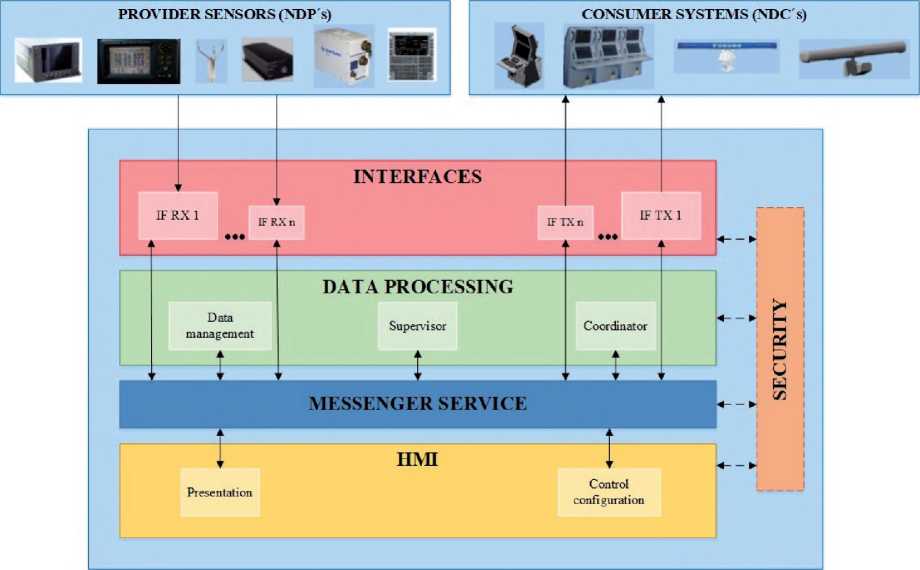
Ship Science & Technology - Vol. 17 - n.° 34 - (17-26) January 2024 - Cartagena (Colombia)
DOI: https://doi.org/10.25043/19098642.246
Francisco Guevara 1
Ronald López 2
Willy Ramos 3
Sergio Mendoza 4
Stefany Marrugo 5
1 R&D Department - COTECMAR. Email: fguevara@cotecmar.com
2 R&D Department - COTECMAR. Email: rlopez@cotecmar.com
3 R&D Department - COTECMAR. Email: wrramos@cotecmar.com
4 R&D Department - COTECMAR. Email: smendoza@cotecmar.com
5 R&D Department - COTECMAR. Email: smarrugo@cotecmar.com
Date Received: October 29th, 2022 - Fecha de recepción: 29 de octubre de 2022
Date Accepted: February 16th, 2023 - Fecha de aceptación: 16 de febrero de 2023
This article presents the challenges faced by the Research and Development Department of COTECMAR in the process of systems integration in naval units. For this purpose, it is used as a case study, the project through which a Data Distribution Unit (DDU) designed for ships of the Colombian Navy was developed and implemented. The methodology implemented for the development of the DDU is shown in summary form, with special emphasis on the implementation and testing phase; likewise, the main drawbacks identified and the most relevant lessons learned related to the integration of hardware and software modules that make up the DDU are presented. In this sense, it was found that in about 30% of the cases, the novelties or difficulties that arose, especially in the software implementations, were due to inaccurate information from the original manufacturers' manuals and undocumented updates. Finally, recommendations are made to improve onboard systems integration processes.
Keywords: Data Distribution Unit (DDU), systems integration, naval systems.
Este artículo presenta los desafíos que enfrenta el Departamento de Investigación y Desarrollo de COTECMAR en el proceso de integración de sistemas en unidades navales. Para ello, se emplea como caso de estudio, el proyecto mediante el cual se desarrolló e implemento una Unidad de Distribución de Datos (DDU) diseñada para buques de la Armada de Colombia. Se muestra de forma resumida la metodología implementada para el desarrollo de la DDU, haciendo especial énfasis en la fase de implementación y pruebas; así mismo, se presentan los principales inconvenientes identificados y las lecciones aprendidas más relevantes, relacionadas con la integración de los módulos de hardware y software que componen la DDU. En este sentido, se encontró que en alrededor del 30% de los casos, las novedades o dificultades que se presentaron, especialmente en las implementaciones de software, obedecieron a información imprecisa de manuales de los fabricantes originales y actualizaciones no documentadas. Finalmente, se emiten recomendaciones orientadas a mejorar los procesos de integración de sistemas a bordo.
Palabras claves: Unidad de Distribución de Datos (DDU), Integración de sistemas, sistemas navales.
The frigate type units of the Colombian Navy's Almirante Padilla class have a Data Distribution Unit (DDU), whose function is to concentrate and integrate the signals obtained from the ship's navigation sensors and, subsequently, distribute them to other sensors and systems that require them for the fulfillment of their mission.
The "Data Distribution Unit" (DDU) that these units currently have was developed during the execution of the modernization process of the Almirante Padilla class frigates Plan ORION (between 2009 - 2011), in order to replace the old and obsolete navigation data retransmission module, known as RTU, which was in charge of receiving and retransmitting the analog signals from the navigation systems to the ship's equipment and systems that required them. With the change in technology from analog to digital, both in the sensors that produce/generate the information and in the equipment or systems that consume or require that information, the need to replace the previous system materialized [1],
The DDU allows centralizing the input signals from the navigation sensors, managing the distribution of the original data from each sensor, monitoring the input data and providing multiple outputs, in different serial and analog formats, proprietary or standard for the different equipment or systems that require such navigation data for their operation [1], Similarly, the DDU is designed to be redundant, in terms of data availability of different variables and the operation of its internal components. Consequently, the main critical elements of the system include backup capability [2],
COTECMAR, as a Science and Technology Corporation, in its role of contributing to the development of capabilities for the Colombian Navy, led the execution of a research project in the field of systems integration in naval units, consisting of the development of a Data Distribution Unit (DDU) prototype; this project represented an important technological and technical challenge, which allowed strengthening capabilities and acquiring knowledge, which is reflected in a functional DDU prototype that was tested in the laboratory and on board an Almirante Padilla Class frigate.
This paper presents the development process carried out by COTECMAR to obtain a functional DDU prototype and the main challenges faced during the execution of projects of this nature on board naval units.
The main objective of the Prototype of a Data Distribution Unit (DDU) for the Frigate type units of the Admiral Padilla class of the Colombian Navy was to integrate the data from the ship's navigation sensors for its distribution to the navigation, surveillance, command and control and/or armament equipment/systems that require it. Such objective would be achieved by receiving the information delivered by the unit's sensors, its management/storage and subsequent distribution [3]. From the system requirements analysis, the DDU Prototype requires the following main hardware components:
Regarding the software components required for the implementation of the prototype, the main modules are described below:
Fig. 1 shows the general software architecture for the DDU Prototype, including the modules and sub-modules described.
Fig. 1.General software architecture for the DDU prototype [7].
The implementation of the design foreseen for the DDU prototype implied the development of several technical information gathering activities on board the ARC Almirante Padilla class frigates. The technical staff of the weapons and electronics department of the ARC Bolivar Naval Base and the support of the units' crews assisted in this process.
As a result of the surveys and review of manuals, 16 links were identified between the existing DDU and its navigation data producers/consumers. These can be derived in sub-links, depending on the equipment that is connected. Likewise, some of the integrated signals are high frequency, so they will require specialized hardware for their processing.
On the other hand, the supply of hardware required for the implementation of the DDU prototype developed by COTECMAR, is composed, among other equipment and accessories, by the following items:
Fig. 2 presents the front view of the implemented DDU prototype. In the image, the different hardware modules described in section 2 can be identified.
Fig. 2. Functional DDU prototype - laboratory test configuration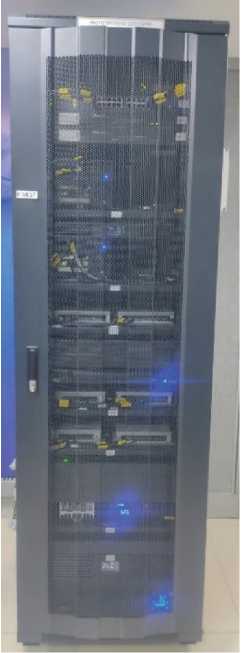
With a view to validate the software and hardware developments of the DDU prototype, a testing protocol was executed, which took place in the laboratory of the R&D department of COTECMAR. The test protocol was divided into test cases [8], as follows:
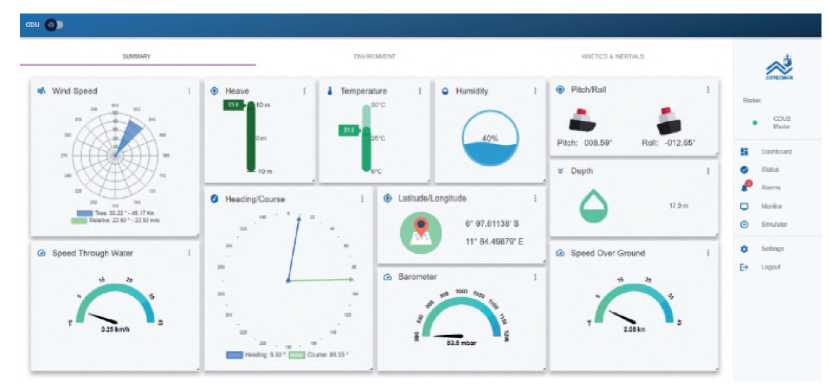
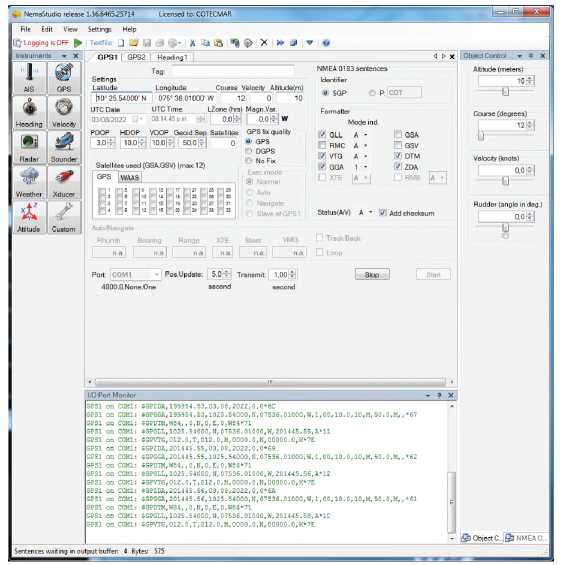
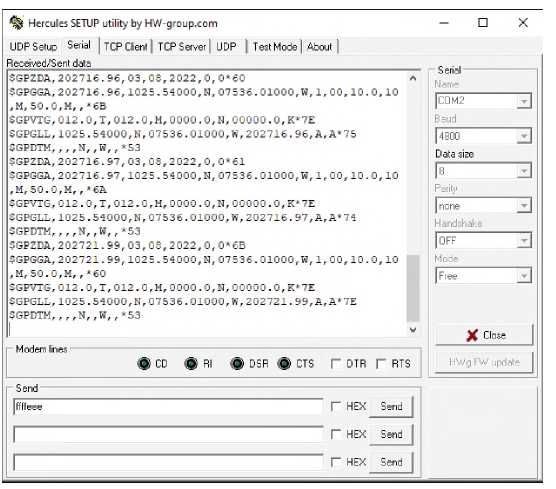
For the execution of this test, in addition to having the applications described in test case 6, it was necessary to have the FASTCOM HDLC frame application (developed by COTECMAR) in a computer.
Fig. 6. Byte stream - HDLC frame monitor [12].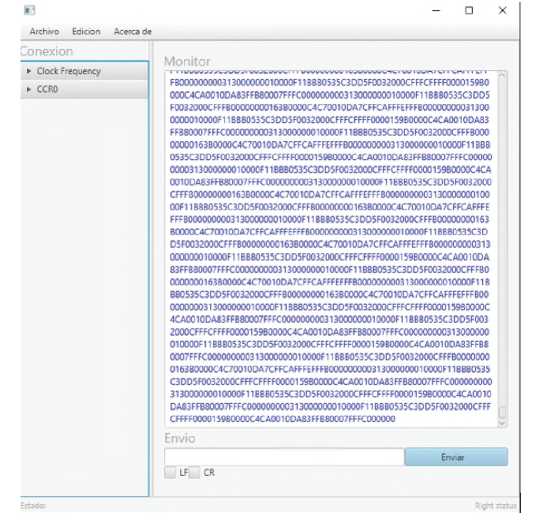
The execution of the described test cases had a duration of one (01) day, under controlled temperature and environment conditions, as follows:
It is important to highlight that the test protocol described was 100% completed, successfully fulfilling the objective of the research project. The validation of the results was carried out by personnel of the Colombian Navy, belonging to one of the Almirante Padilla class frigates.
Considering the results obtained in the laboratory tests, the Colombian Navy requested to execute tests of the DDU prototype on board a Frigate. This implied making some adjustments to the hardware and software modules of the system, to adapt them to the operational environment on board; this process lasted approximately four (04) months. In general terms, the ARC personnel of the Frigate expressed their acceptance towards the prototype developed thanks to the successful integration of the navigation and combat systems on board. Although there were some novelties and opportunities for improvement during the test period, all of them were addressed and solved in a timely manner by COTECMAR.
Fig. 7 shows the prototype DDU developed by COTECMAR installed (provisionally) on board a frigate for testing in a real operating environment.
Fig. 7. Functional DDU prototype-testing aboard a frigate.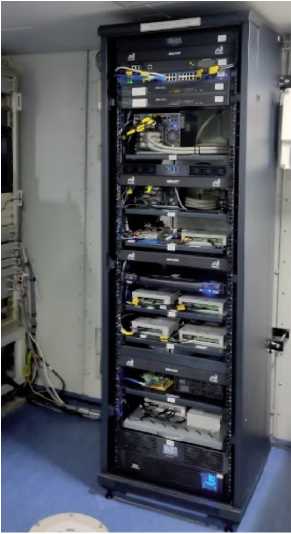
The development process of the DDU prototype involved the analysis and solution of some situations that materialized and that, in some way, became challenges that had to be solved and managed to achieve the successful execution of the project.
Tables 1 and 2 describe some of the situations identified, classifying them according to whether they applied to hardware or software modules.
Table 1 Challenges - hardware modules.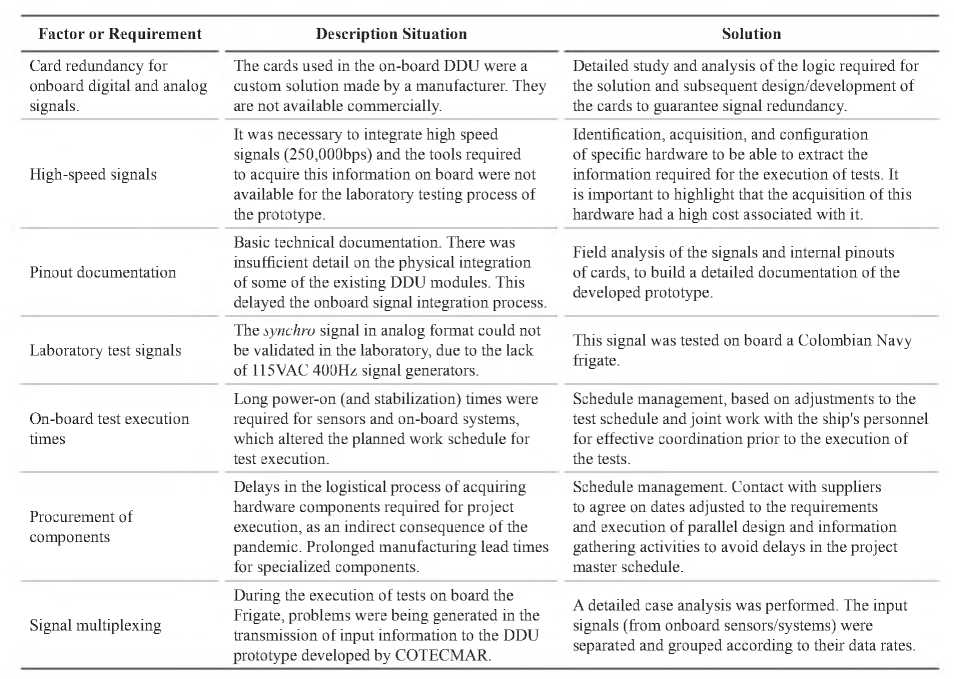
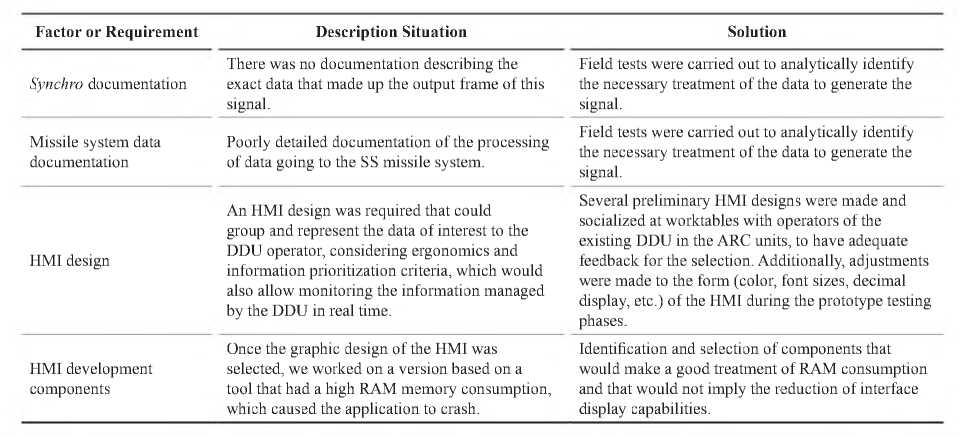
The application of the existing knowledge and capabilities in the R&D department of COTECMAR, allowed the development of a functional prototype of a Data Distribution Unit - DDU, adjusted to the requirements of the Almirante Padilla class frigates of the Colombian Navy. In this sense, the functional validation of the development was done both in the laboratory and in a real operational environment (on board a frigate), obtaining successful results in both cases.
Likewise, this project allowed the appropriation of new knowledge and capabilities related to systems and sensors integration, especially regarding the management of onboard analog signals and their respective digitalization.
Likewise, based on the technical challenges and difficulties encountered during the prototype development process, the following conclusions or lessons learned are generated, as follows:
The authors would like to thank the crews of the frigates of the Colombian Navy for their support in the development and testing process of this project, as well as the personnel of the Weapons and Electronics Department of BNL01 for their support in the design and validation process of the prototype.
[1] COTECMAR. System Requirements Specification - DDU Prototype, pp. 8-9. Available at COTECMAR COT 2101 - DDU PROJECT DOCUMENTS. Accessed 202210-26.
[2] COTECMAR. System Requirements Specification - DDU Prototype, pp. 22-23. Available at COTECMAR COT 2101 - DDU PROJECT DOCUMENTS. Accessed 202210-28.
[3] COTECMAR. System Design - DDU Prototype, pp. 11. Available at COT 2101 -DDU PROJECT DOCUMENTS. Accessed 2022-11-18.
[4] COTECMAR. System Design - DDU Prototype, pp. 13-16. Available at COTECMAR COT 2101 - DDU PROJECT PROJECT DOCUMENTS. Accessed 202211-24.
[5] COTECMAR. System Design - DDU Prototype, pp. 23. Available at COT 2101 -DDU PROJECT DOCUMENTS. Accessed 2022-11-27.
[6] COTECMAR. System Design - DDU Prototype, pp. 17-20. Available at COTECMAR COT 2101 - DDU PROJECT DOCUMENTS DISI. Accessed 2022-11-26.
[7] COTECMAR. System Design - DDU Prototype, pp. 25. Available at COT 2101 -DDU PROJECT DOCUMENTS. Accessed 2022-11-27.
[8] COTECMAR. Factory test protocol - DDU prototype, pp. 15-40. Available at: WCOT 2101 PROJECT - DDU Technical Documents. Accessed on 2022-12-22.
[9] COTECMAR. Factory test protocol -Prototype DDU, pp. 62. Available at: WCOT 2101 - DDU Technical Documents - DDU Technical Documents. Accessed on 2022-1223.
[10] COTECMAR. Factory test protocol - DDU prototype, pp. 71. Available at: WCOT 2101 -DDU Technical Documents - DDU Technical Documents. Accessed on 2022-12-23.
[11] COTECMAR. Factory test protocol -Prototype DDU, pp. 100. Available at: W COT 2101 PROJECT - DDU Technical Documents. Accessed on 2022-12-23.
[12] COTECMAR. Factory test protocol - DDU prototype, pp. 106. Available at: WCOT 2101 - DDU Technical Documents - FAT. Accessed on 2022-12-23.